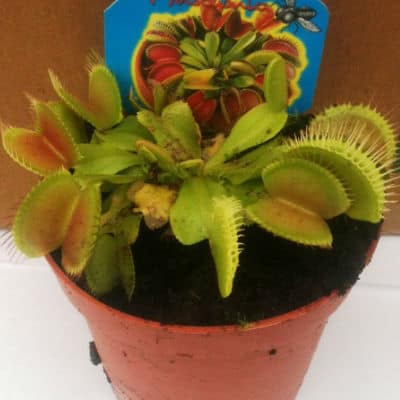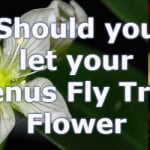Last updated on January 26th, 2022
Our site is reader supported, this means we may earn a small commission from Amazon and other affiliates when you buy through links on our site.
Venus fly trap facts
They have amazed people for generations and they are one of the best known out of all the carnivorous flesh-eating plants in the world. They are loved by children and adults alike and you never get bored watching the snapping jaws as they catch their unsuspecting prey.
Be ready to be amazed and learn more about these amazing plants, read on to learn more!
1. Do you know its scientific name?
The Venus fly trap’s scientific genus name is ‘Dionaea muscipula’ and it is one of many types of fly-eating plants.
2. They can only be found in the wild in one small place
They can be purchased from many garden centres, nurseries and even on Amazon. But did you know that they are only native on the coast of North and South Carolina in the United States Of America?
3. Did you know that they are an endangered species and protected?
Because of their huge popularity, they have actually become endangered in their native Carolina, USA and it is illegal to take them from the wild and the plants you purchase are propagated by specialist nurseries.

4. They live in very poor soil and feeding with a fertiliser can kill them
Venus fly traps live in very poor acidic soil where there are very few nutrients in the soil so they have adapted to getting essential nutrients from the sun and by using the pod traps to trap insects and digest them to receive the nutrients they need.
5. They eat insects and bugs which you probably know, but did you know they even eat small frogs?! If you don’t believe me watch the video!!
Venus fly traps will eat any kind of insect that is unfortunate enough to crawl into the jaws of its traps. They have red inside the trap that helps to attract the insects. They will also eat small frogs that make their way into the trap. It takes around 10 days for the trap to digest its catch and one trap will close approximately 6 times before the trap turns black and dies.
6. Did you know they can survive warm temperatures and snow?
In North and South Carolina where they are native to it is often cold. When it snows during the winter, the plants go dormant before growing again in spring. If you grow them indoors they also go dormant from around October before starting to put on new growth in spring.
6. You need to grow them in moist, acidic soil
They grow in moist, swamp bogs in the wild and when growing them in your home you need to replicate this. Simply mix 50 parts peat with 50 parts perlite, the peat is acidic and the perlite helps drainage and retains moisture.
7. If you grow them from seed no two plants are ever the same
Venus fly traps can be cultivated from seed but did you know that no two plants are the same? In fact, they are all genetically unique.
8. They need full sun to thrive and lots of it
These fly-catching plants need at least 8-10 hours of sunlight per day to be able to digest their food properly. A sunny windowsill is perfect.
9. They can last long periods of time without eating insects if necessary
They can last up to 1-2 months without catching food and can live for up to 15 years.
10. They have small hairs inside the trap that sense pray and close they trap within 1 second
They have six trigger hairs in total. Three on each side of the trap and it takes two stimulations of one hair to trigger the trap to close. Never trigger the traps yourself just to close them, this wastes vital energy on closing them.
11. You can feed them live flies and dead flies
They can eat live and freshly killed flies. If you are feeding the trap a dead fly ensure you move the fly about to trigger the trap and that it can comfortably fit in the trap.
12. Venus fly traps can eat people
Only joking, but they are capable of eating strips of human flesh if you could place them in the trap. Don’t try this though!



